Peer Integration and Enhancement Resource (responsible expert: University of Sussex, UK; implementing partners: University of Sussex, UK; University of Tampere, Finland)
The PIER intervention works with a Manual and an Implementation protocol.
Watch our short video here explaining the PIER intervention
The intervention builds on research undertaken by Watters and colleagues (2009) in schools in the UK that observed an integrationist attitude as positively associated with two psychosocial outcomes: self-esteem and peer acceptance. The findings provided strong support for Berry’s (1997) prediction that an acculturation attitude that combines both culture maintenance and intergroup contact will have the most favourable prognosis for well-being.
However, the research found that an integrationist outlook at one time point predicted a greater number of negative emotional symptoms suggesting that endorsing integration was something of a two-edged sword: it increased self-esteem and acceptance by peers, but also led to manifesting more negative emotional symptoms. The research indicated that the quest to be integrated, involving engagement alongside cultural maintenance may have consequences in terms of discriminatory behaviours.
In a study of educational achievement in Belgian secondary schools, it was found that an integrationist orientation was linked to academic success only for students who experienced relatively low levels of discrimination; for those reporting higher levels of discrimination, academic achievement was noticeably lower (Baysu, Phalet & Brown, 2011).
A helpful orientation towards examining intergroup interactions in this context is to focus on the generation of social capital, specifically the ways in which both bonding and bridging social capital is developed in schools. Previous research has demonstrated the close relationship between bridging social capital and an integrationist approach (Watters et al., 2009). This intervention provides an opportunity to examine strategies aimed at developing positive peer interactions and social support in the context of multi-ethnic schools.
PIER has been initially based in a school that has introduced refugee children in recent years and has been active in trying to support an integrative approach. The school offers specific initiatives aimed towards enhancing students integration including classes aimed at appreciating cultural diversity and focussed on the `World on the Move’ that aims to enhance understanding of migratory processes.
You want to know more? Click here or have a look at the resources!
Resources
PIER_Manual. Watters, C., Soye, E., & Meier, I. (2021). Peer Integration and Enhancement Resource (PIER) Manual. UK: University of Sussex.
PIER Implementation Protocol. Soye, E., Watters., C. & Punamäki, R.L. (2021). RefugeesWellSchool implementation protocol: Peer Integration and Enhancement Resource (PIER). Sussex, Gent: University of Sussex, Ghent University.
Peltonen, K., Aalto, S., Vänskä, M., Lepistö, R., Punamäki, R.-L., Soye, E., Watters, C., de Wal Pastoor, L., Derluyn, I., & Kankaanpää, R. (2022). Effectiveness of Promotive and Preventive Psychosocial Interventions on Improving the Mental Health of Finnish-Born and Immigrant Adolescents. International Journal of Environmental Research and Public Health, 19(6), 3686. https://doi.org/10.3390/ijerph19063686
-
In-service teacher training
The aim of the INSETT intervention is to enhance teachers’ insight into how refugee /migration experiences may impact young people’s psychosocial well-being and school functioning upon resettlement in a new country (Brenner & Kia-Keating, 2016; Pastoor, 2015, 2017).
See how it works
-
Welcome To School
This intervention builds on the Welcome to School initiative developed by the Pharos Refugees and Health Knowledge Centre (the Netherlands), with support from the European Refugee Fund. Rooted in the theoretical principles of social capital, the Welcome to School Initiative seeks to strengthen the competencies of refugee and migrant youth with regards to self-esteem, coping, social skills and behavioral adjustment.
See how it works
-
Classroom Drama intervention
In a nine-week drama workshop intervention program, refugee and migrant adolescents in multi-ethnic schools work around the construction of group stories that support the construction of identity and meaning, aiming to establish bridges between past and present and to engage with themes of migration, exclusion, pluriform identities and cultural adaptation in host societies.
See how it works
-
Teaching Recovery Techniques + In-service Teacher Training
Teaching Recovery Techniques is a manualized intervention developed by the Children and War foundation (Yule, Dyregrov, Raundalen, & Smith, 2013). TRT is based on trauma focused cognitive behavioral therapy (TF-CBT) and includes seven sessions for young people and two for the caregivers. For children, session one is about getting to know each other and session seven a follow-up.
See how it works
-
PIER intervention
The intervention ‘Peer Integration and Enhacement Resource’ (PIER) develops a participatory approach to supporting safe, positive peer interactions and social relationships in multi-ethnic schools. Through clustering pupils with migrant and non-migrant background in small collaborative groups working together on establishing social connection and participatory activities in the school context, the intervention aims at strengthening school belonging and promoting dialogue between minority and majority groups.
See how it works
